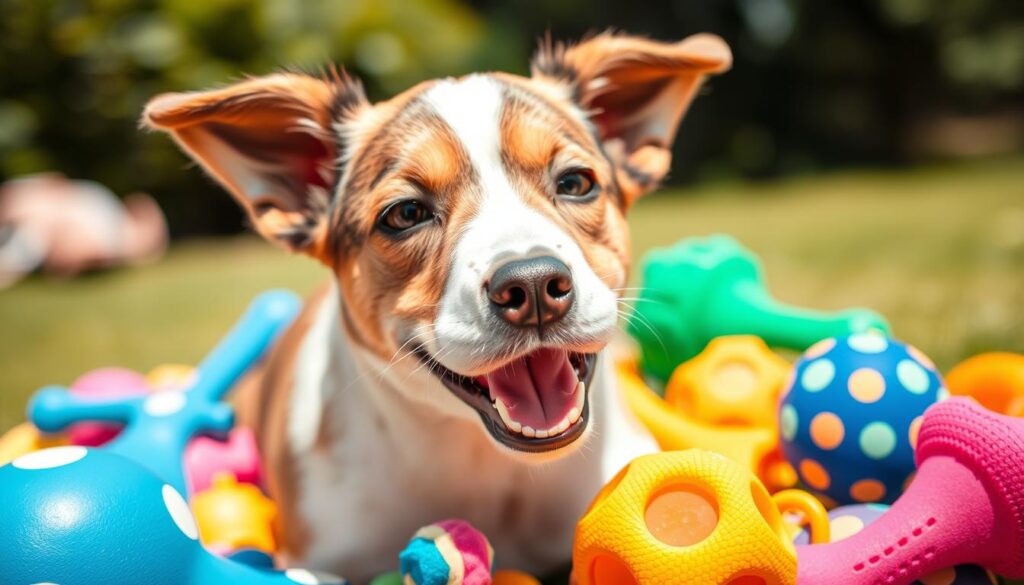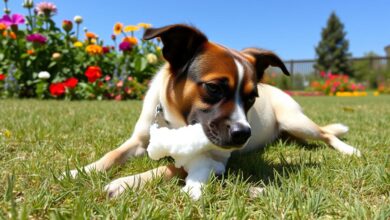Dog Side Eye: What Your Pup’s Look Really Means

If you’re a dog owner, you’ve seen your pet’s interesting “side eye” looks. These glances might seem cute or quirky. But, they can actually mean a lot more than that.
Understanding what your dog’s side eye means can strengthen your bond. It also helps keep them happy and healthy.
Table of Contents
Key Takeaways
- Dog side eye, also known as “whale eye,” is a sign of discomfort, fear, or anxiety in canines.
- Brachycephalic breeds like Boxers, Bulldogs, and Pugs are more prone to displaying side eye due to their facial structure.
- Accompanying body language cues like lip licking, frozen posture, and avoiding eye contact can indicate your dog’s emotional state.
- Misinterpreting side eye as a harmless glance can lead to escalated behaviors like biting or charging.
- Proactive interventions, such as removing perceived threats and giving your dog space, can help alleviate side eye in 90% of cases.
Read Also : Are Chicken Feet Good for Dogs? Health Benefits and Safety Tips
Understanding Dog Side Eye
Dog side eye, also known as the “whale eye,” is a key part of how dogs show their feelings and talk to us. It happens when a dog looks at something but turns their head a bit away. This lets us see the white of their eyes.
What is Dog Side Eye?
The side eye lets dogs watch their surroundings and spot dangers easily. They can do this by just turning their head a little. Dogs see more than we do because their eyes are on the sides of their head.
The Anatomy of Side Eye
Dogs’ eyes are different from ours, which helps them do the side eye. They see colors differently and have eyes on the sides of their head. This lets them see more and still focus on what they’re interested in.
Knowing how dogs do the side eye helps us understand them better. It lets us know how they’re feeling and helps us connect with them more.
Common Situations for Side Eye
As dog owners, we’ve all seen our dogs give us that famous “side eye.” It’s a sideways glance that seems to say a lot. But what are they really trying to tell us? Dog side eye can mean different things in various situations, giving us clues about their feelings and behavior.
Dogs can see more than we can, thanks to their wider field of vision. They can spot threats or discomfort more easily. When they feel uneasy, they might give us a side eye to show their anxiety. It’s their way of saying, “I’m not okay with this.”
But side eye can also mean they’re curious or alert. If something catches their attention, they might glance at it sideways. This shows they’re interested and want to keep watching without staring directly.
Side eye can even be playful in dogs. When they’re ready to play, they might look at us sideways to start the fun. It’s their way of saying, “Let’s play! I’m excited!”
Understanding when your dog gives you side eye is important. By watching their body language and facial expressions, you can understand what they’re feeling. This helps you respond better to their needs and strengthens your bond with them.
The Emotional Spectrum of Dog Side Eye
The side eye in dogs can mean many things. It can show canine anxiety or just dog curiosity. Knowing what a dog’s side eye means can help you understand their feelings and health.
Communicating Discomfort or Anxiety
If a dog looks at you with a side eye, they might be feeling uncomfortable or anxious. Look for other signs like a tucked tail or raised hackles. Finding out why they’re feeling this way is key to making them feel safe.
Expressing Curiosity or Alertness
But, a relaxed side eye can mean they’re just curious or alert. Dogs use their side vision to watch their surroundings. This is often seen when they’re playing or exploring, showing their interest in the world.
To really understand what a dog is feeling, look at their whole body. Notice their ears, tail, and how they’re standing. Knowing about dog side eye emotions can make your bond with your dog stronger.
| Emotional State | Body Language Cues | Appropriate Response |
|---|---|---|
| Discomfort or Anxiety | Tucked tail, raised hackles, low growls | Identify and address the root cause of stress |
| Curiosity or Alertness | Relaxed body, attentive gaze | Provide enrichment activities to channel their interest |
Understanding a dog’s side eye can help you meet their needs better. This way, you can build a strong, caring relationship with your dog.
Showing Playfulness Through Side Eye
Dogs can show playfulness with the side eye too. They might turn their head a bit while watching their playmate. This is like a playful tease or challenge. You’ll also see other signs like bowing, wagging their tail, and gentle nudging.
Playful Cues
When your dog gives you the side eye, it means they’re ready for fun. Look for other signs like:
- Lowered, wagging tail
- Playful bowing with their front legs
- Gentle nudging or paw taps
- Bouncing or “zoomies” around the play area
Safe Play Practices
The side eye shows your dog wants to play, but play must be safe. Always watch over them. Give them the right toys and chew items to keep their play positive. This keeps everyone safe and happy during play.

“Paying attention to your dog’s body language and responding appropriately can help foster a stronger bond and better communication during playtime.”
Seeking Attention with Side Eye
Dogs are experts at sending messages without words. The side eye is a key part of their language. It can show many feelings, like curiosity or worry. But, it also means they want your attention.
They might use other signs too, like pawing, whining, or nudging. These actions show they’re looking for something from you.
Recognizing Attention-Seeking Behavior
When your dog looks at you with the side eye, watch their body language. Are they waiting for something? Do they seem upset or restless?
These signs mean they want your attention. It could be for a walk, a treat, or just to spend time together.
Avoiding Negative Reinforcement
It’s key to answer your dog’s needs quickly. This helps them learn good behaviors. But, don’t reward bad actions like barking or jumping.
Setting clear rules and teaching them to ask nicely is important. This way, you and your dog can grow closer.
Remember, canine attention behaviors are a big part of how dogs talk to us. By noticing and responding to their dog side eye attention-seeking signs, you help them learn good ways to ask for things. This makes your bond stronger.
Establishing Boundaries with Dog Side Eye
Dogs use side eye, or “whale eye,” to show many feelings, like curiosity or discomfort. This special way of communicating can also mean they need space. It’s important to respect their need for safety and space to build trust and avoid stress.
Respecting Their Space
Dogs see more than humans from the corner of their eye. This makes them sensitive to threats or intrusions. Teaching them commands like “leave it” or “stay” helps when they feel their dog side eye boundaries are being crossed.
Creating a Safe Space
Having a special dog safe spaces gives your dog a place to relax and feel secure. This could be a crate, a room, or a quiet corner. By giving them their own canine personal space, you help them feel in control and less likely to use side eye defensively.
It’s key to respond well to your dog’s side eye by respecting their boundaries. This helps build trust and a strong bond with your dog.

“Observing a dog’s general body posture is essential to confirm if a side-eye is present; stressed dogs may exhibit behaviors like pacing, barking, or shaking.”
The Role of Socialization in Dog Side Eye
Proper dog socialization is key to how dogs communicate, including side eye. Puppies need to meet many people, animals, and places early on. This helps them grow into calm adults, reducing fear-based side eye.
Keeping up with socialization and positive experiences keeps dogs confident and reduces anxiety. This is often the main reason for side eye.
Putting your dog in socialization classes or working with a canine communication trainer is a great idea. These classes offer chances for dogs to learn good social cues and build trust. This leads to more confident and relaxed side eye.
Regular exposure to new situations and friendly faces keeps dogs calm. Owners who socialize their dogs early on see less anxiety-related side eye as they get older. Dogs learn to see side eye as playful, not scary.
“Proper socialization is key to helping dogs develop into well-adjusted, confident companions. By exposing them to a variety of experiences, we can reduce anxiety-driven behaviors like side eye and promote healthy canine communication.”
Socialization is important at any age. Keeping dogs comfortable with new things helps prevent dog anxiety and side eye. With patience and positive reinforcement, owners can turn side eye into a friendly gesture.
Conclusion
Understanding your dog’s body language, like the side eye, is key to a strong bond. By learning to read their cues, you can meet their needs and make them feel loved and safe. Watching their behavior and getting help when needed can make your bond stronger and improve their life.
Getting good at understanding your dog’s side eye can give you insights into their feelings. It helps you create a better environment for them. You’ll know when they’re feeling anxious or just curious, which strengthens your connection.
Building a strong bond with your dog is a journey of understanding and trust. By paying attention to their body language, including the side eye, you’re on the right path. This will help you strengthen the dog-owner bond, improve their canine body language, and make your dog feel truly understood and dog side eye understanding.
FAQ
What is dog side eye?
Dog side eye, or “whale eye,” is when a dog looks at something but turns their head slightly away. This makes the whites of their eyes show. It’s a way for dogs to keep an eye on their surroundings and any dangers.
What does dog side eye communicate?
Dog side eye can mean many things, like feeling anxious or curious. It can also show playfulness or a desire for attention from their owners.
How can I tell if my dog is feeling uncomfortable or anxious from their side eye?
If your dog’s side eye is with other signs like a tucked tail or raised hackles, they might be stressed. Finding out why they’re stressed is key to making them feel safer.
Can dogs use side eye to communicate playfulness?
Yes, dogs use side eye to show they’re ready to play. They might turn their head slightly while keeping an eye on you. This is like a playful challenge. Other signs of playfulness include bowing, wagging, and gentle nudging.
How can I tell if my dog is seeking attention with their side eye?
If your dog’s side eye is with pawing, whining, or nudging, they want something. This could be food, a walk, or just some love. Meeting their needs quickly can encourage good behavior, but avoid rewarding bad habits.
How can I establish boundaries with my dog using their side eye?
It’s important to respect your dog’s need for space and safety. Teaching them commands like “leave it” or “stay” helps in situations where they feel threatened. Also, giving them a safe place, like a crate or room, helps them feel secure.
How does socialization affect a dog’s use of side eye?
Socialization is key for how dogs communicate, including side eye. Introducing puppies to different people, animals, and places early helps them grow into confident dogs. This reduces fear-based side eye as they mature.





